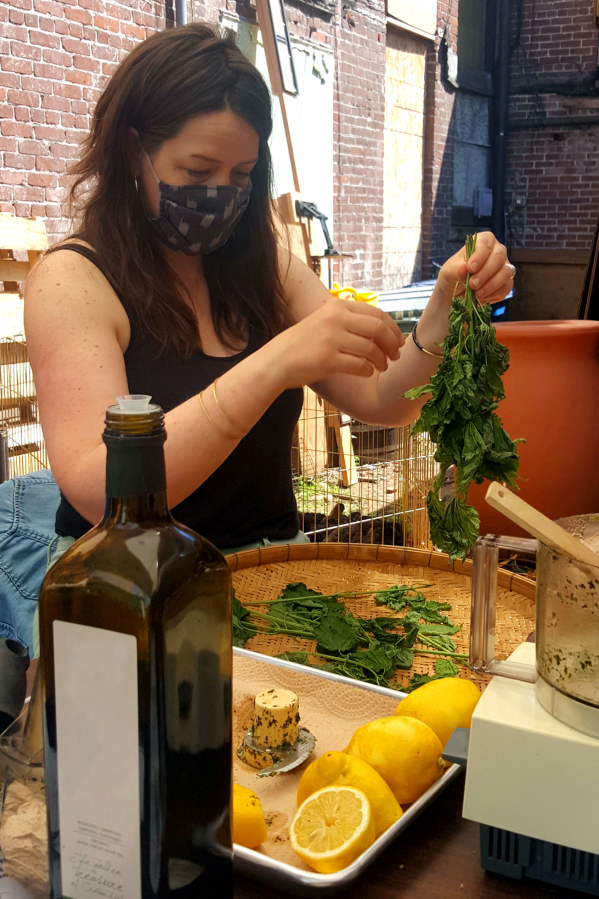If you’ve ever brushed bare skin against a nettle leaf, resulting in a painful burning sensation that can last for days, chances are you’re not fond of this herbaceous flowering perennial. Most Northwesterners have learned to avoid this stinging plant, often found in meadow glades or the damp soil near creeks or rivers.
Nettles, however, are a versatile herb that can be used in everything from food to clothing. Scratch the surface of the internet and you’ll find recipes for sauteed nettles, nettle soup, nettle butter, nettle risotto and nettle bread. Homeopathically, it’s used to treat arthritis, hay fever and high blood pressure, among many other things. If you’re willing to pay upwards of a couple hundred dollars, you can even own a nettle fiber dress or shawl.
“It’s just like a total goddess herb,” said Emily Reudink of Hedgerow Herbs, a self-defined “folk herbalist” who recently taught a workshop about nettles at Kindred Homestead Supply in downtown Vancouver. She was careful to say that she doesn’t prescribe herbs to treat medical conditions but is happy to share her robust knowledge of herbal remedies.
In Kindred’s courtyard teaching space, against a backdrop of chirping birds and clucking chickens, Reudink led students through two information-packed hours about the many uses of nettles. Reudink made nettle pesto, nettle-infused vinegar and nettle tea. She brought samples of nettle tincture as well as dried and fresh nettles.
Reudink used her bare hands to handle the stalks as she talked, admitting that her fingers were tingly. Dried nettles lose some of their sting and it disappears altogether when sauteed or doused in boiling water, she said.
The sting comes from trisomes — tiny, hollow hairs, mainly on the underside of leaves and on stems, that inject a mix of formic acid, histamines and acetylcholine into unwitting passersby. Fortunately, the sting can be neutralized by applying a poultice of dock leaves, chickweed, yarrow, jewelweed or alder leaves, many of which naturally grow near nettles.
Nettle leaves and roots are rich in vitamins A, B, C and K, as well as minerals like magnesium, phosphorus and potassium. Nettles are packed with calcium and are found in many herbal remedies to promote bone health. Their high iron content makes them an excellent tonic for iron lost during heavy menstruation or postpartum bleeding, Reudink said, or as a pick-me-up after any exertion that leaves you feeling depleted or worn down. Nettles are good for everyone, but in herbal lore they are more associated with women.
“I could say most or all the women I know carry a heavy load,” Reudink said, “and nettles are deeply restorative to the blood and the energy.”
One of the most efficient ways to get all that vitamin and mineral goodness out of nettles is to make an infusion, as Reudink does. Pour boiling water over a jar full of fresh leaves and stems, leave it in the fridge overnight, and strain out the solids with a colander or cheesecloth. Drink it cold or hot with a little honey.
The taste of nettles might not be for everyone, but Reudink likes their grassy, earthy flavor, distinct from other oily herbs like oregano or rosemary.
“They have a mineral-rich flavor, which can be hard to describe,” Reudink said. “It’s a general herbaceous taste, a green, chlorophyll-rich taste.”
For intense nettle flavor, try Reudink’s formula for nettle pesto: fresh nettles, walnuts, olive oil, garlic cloves and sea salt. The olive oil and the pulverizing remove the sting, she said. As she made the pesto — noting that there’s no real recipe, just add ingredients in whatever amount seems right — she suggested experimenting by adding other herbs or nuts.
If you want to make your own teas or infusions, you can find dried nettles in bulk at Kindred Homestead Supply, 606 Main St., and at the newly opened Dandelion Teahouse and Apothecary, 109 W. Seventh St. Many health-food stores sell nettle leaf tea and nettle tinctures (nettle concentrate in alcohol).
For fresh nettles, Reudink simply strolls out to her own garden. She enthusiastically recommends having nettles right at hand; @sisternettleplants on Instagram is a good local source for seedlings, she said.
“You don’t have to be tromping around in the wild,” Reudink said. “You can grow them in your yard. You can even grow them in a container or in a terra cotta pot if you’re a city dweller and you don’t have a yard.”
If you do want to collect wild nettles, Reudink offers some cautions. Don’t gather downstream from an industrial area or factory farm, as the nettles could absorb harmful effluents. Check, if you can, to confirm that no chemicals have recently been sprayed in the area. Make sure that you’re allowed to remove plants, because some parks and trails prohibit plant-gathering.
Though nettle stings don’t result in long-term harm, you’ll be far more comfortable if you gather while wearing gloves, long sleeves and pants. Leave dogs at home when foraging because nettles can be just as irritating to a dog’s skin.
Reudink harvests the leafy tops of nettle stalks before they’ve gone to flower. She leaves the bottom half of the stalk intact, she said, because this will allow the plant to branch out and produce even more nettles to harvest later.
Most of all, Reudink hopes that people will stop being afraid of the nettle’s sting (“Just put on gloves. It’s OK!”) and enjoy its many benefits.
For further reading on nettles and other wild herbs, Reudink recommended “From Earth to Herbalist,” by Gregory L. Tilford, or contact Reudink through Instagram at @hedgerow_herbs. You can also meet her in person at Kindred Homestead Supply, where she’ll teach a workshop about calendulas on June 12. Register at www.kindredhomesteadsupply.com.




